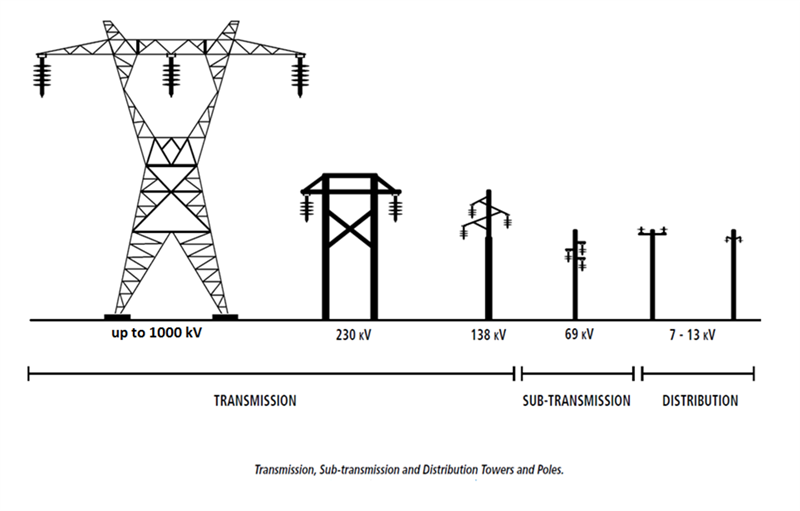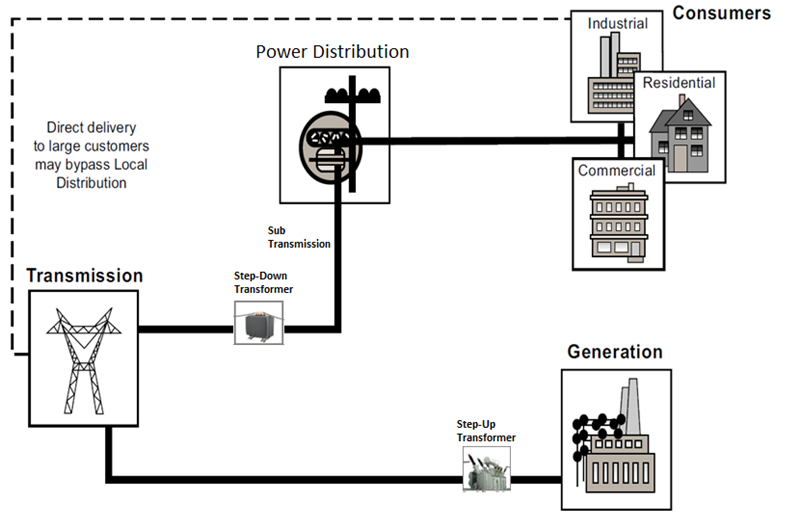The electrical grid is an integration of a number of systems that perform specific functions. The systems include primary equipment, secondary equipment, automation, test and maintenance equipment and support systems for delivering power from the generator to consumers. The electrical grid systems' functionality can be broadly classified into:
- Power generation, power transmission, power distribution and power consumption
- Substation, substation automation and digital substation
- Distributed energy resources (DER) , smart grid and smart cities
- Distribution automation (DA) and grid communication
- Protection, control and monitoring
- Power quality analysis and power factor correction (PFC)
- Smart meter reading (AMR) and advanced metering infrastructure (AMI)
Source: www.samlexamerica.com
Power generation, power transmission and power distribution systems
- Power generation system: Electricity is generated by fossil fuel power plants, nuclear power plants and renewable energy facilities such as hydroelectric dams, solar photovoltaic systems, wind turbines and biomass power plants. These power generation facilities produce energy for use by consumers
- Power Transmission: Step-up substation transformers raise the voltage of the generated electricity for efficient transportation. Transmission networks are used to transport bulk electricity over long distances to substations near population centers using overhead and underground power transmission lines
- Power distribution and consumers: Step-down substation transformers lower the high-voltage to a lower distribution voltage. Distribution lines transports electricity to the final destination like a home or business where electricity is used to power everyday life including appliances, lighting and heating
Customer solutions for power generation, transmission and distribution include generators, power transformers, HV, MV and LV switchgear, protection, control and monitoring, feeder automation, power circuit breakers, SCADA and other solutions. Some of the systems used along the grid are listed below:
|
Generation
|
|
|
Transmission and sub-transmission |
|
|
Power distribution and consumption
|
|
The subsystems that are integrated into the above products are classified below:
|
Subsystem |
Description |
|
Processing unit |
Microcontroller (MCU), microprocessor (MPU), digital signal processor (DSP), ASIC or FPGA, memory systems, supervisors, power sequencers, level converters, LVDS and digital logic |
|
Voltage and current measurement (AC/DC) |
Shunt, current transformers, voltage transformers, potential divider, hall-effect current sensors and flux-gate current sensors |
|
Analog input signal processing |
PGA, instrumentation, differential and isolation amplifiers, ADCs SAR, Delta-Sigma and pipeline ADCs and references |
|
Isolated voltage and current measurement |
Isolated Delta-Sigma modulators and fully-differential isolation amplifier |
|
Wired communication |
Ethernet, USB, HUBs, RS232, RS485, RS422 and telephone MODEM |
|
Wireless connectivity |
Low-power RF, Bluetooth®, Wi-Fi ®, GSM and GPRS MODEM |
|
Power supply |
AC/DC, DC-DC, LDO, PMU, PMIC and power modules |
|
Discrete input and output (Analog and Digital) |
ADC and DAC solutions for low-voltage and low-current DC transducer input or output. Digital isolators for isolation to the signals with the host processor. Binary input and Binary output. |
|
Internal and external sensors |
Internal on-board temperature sensing, pressure and humidity sensing, external temperature sensing like RTD, thermistor and fiberoptic-based temperature sensing |
|
HMI/User interface |
LCD, touchscreen, backlight, LEDs, keypad |
|
Battery power and management |
Battery chargers, battery gauging and authentication |
|
Motors and solenoid control |
MOSFETs, isolated and non-isolated IGBT gate drivers and solenoid drivers |
TI’s role
TI has a large portfolio of products for the above applications including MPU/MCU/DSP, analog signal conditioning and processing, wired and wireless connectivity and power management.
Additionally, TI offers evaluation boards and modules for quick evaluation and testing of the products. TI also has subsystem designs as a reference for many of the above applications, which have been tested for functional, temperature drift and compliance to EMI/EMC as applicable. TI provides subsystem design data for customer usage and easy integration which includes:
- Design guide with test results, graphs and setup information
- BOM with component ordering information, Schematics, PCB and Gerber
Additionally, you can receive online support through the TI E2E™ community.
Some of the Relevant TI Design reference designs:
|
Signal processing and analog front end (AFE) |
|
|
I/O |
|
|
Communication |
|
|
Power supply |
For more information on the TI Design reference designs that could help accelerate your project for the above applications, visit here.
Additional resources:


